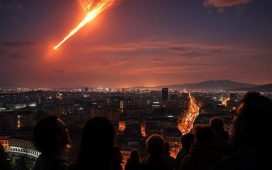A toolkit dropped by astronauts on the International Space Station (ISS) earlier this month will be visible from the ground as it floats over the UK this week.
The bag went awol during a space walk by Jasmin Moghbeli and Loral O’Hara, who spent a gruelling six hours and 42 minutes outside the ISS on November 2 completing maintenance work.
Flight controllers spotted the errant kit slowly drifting out into space, but Nasa quickly determined it posed no threat to the station and could be left to continue its lonely orbit.
It will eventually fall back to Earth, burning up in the atmosphere at around 70 miles above the surface, but for now it is still whizzing around the planet at about 7km/s.
And this week, as the ISS passes over the UK, people on the ground with a set of binoculars will be able to see the tool bag for themselves.
From Friday, the ISS will begin an eight-day stint soaring over the country twice every evening, between about 5pm and 8pm each night.
Stargazers can check when the station will be passing over their area here, along with where in the sky it will appear, and how long it will be visible for.
Its tiny toolkit friend will be flying overhead about two to four minutes ahead of the station.
Follow Metro on WhatsApp to be the first to get all the latest news
Want to be the first to hear the world’s top stories? Metro.co.uk is now on WhatsApp sending updates and trending stories straight to your phone.
Join the Metro WhatsApp community for breaking news, juicy showbiz stories and must-watch videos from across our website.
We’ll send you updates all day long, so you never miss a story! You can have your say by taking part in polls and reacting to messages.
To join our Metro community, just follow these two easy steps.
Simply click on this link, select ‘Join Chat’ and you’re in!
The bag has a visual magnitude of about 6, which means it is unlikely to be visible to the naked eye – but a pair of binoculars should do the trick.
However, anyone hoping to catch a glimpse will need a clear night, and a wide ISS orbit. On some days it won’t be very high in the sky, meaning it is only visible for a minute or two, and more affected by light pollution.
While a floating tool bag is one of the weirdest things in the sky right now, it is far from the only thing worth wrapping up for.
Tonight Uranus will be at its biggest and brightest as it moves into opposition, meaning it is directly inline with the Earth and the Sun, and the closest to our planet it gets.
While slightly brighter in magnitude than the tool kit, it will still be tricky to see with the naked eye – but again, a pair of binoculars should enable a cracking view.
MORE : Tim Peake is hiding a secret about his time in space
MORE : Astronauts just took one giant leap towards having sex in space
MORE : Danish astronaut whips up chocolate mousse in space
Follow Metro across our social channels, on Facebook, Twitter and Instagram
Share your views in the comments below
Get your need-to-know
latest news, feel-good stories, analysis and more
This site is protected by reCAPTCHA and the Google Privacy Policy and Terms of Service apply.












